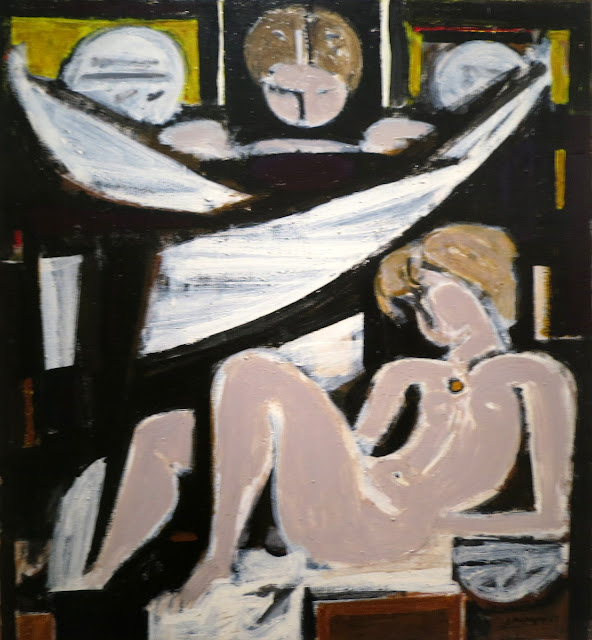Yannis Moralis
at the Stavros Niarchos Cultural Centre, Athens.
'My first sniff of oil paint was at my aunt's house, my mother's sister, who was a painter. It was then that I first started to draw. I went to the school with my father, picked up a few pieces of chalk, dipped them in blue and red ink, and drew on the class board in three colours - blue, red and white. I used to make geometric drawings using paper lines as a starting point on left-over exam paper. In the gymnasium building I would gaze at displays of funerary offerings, weaths and other objects that excited my imagination. Sometimes I wonder whether some of the things that turn up in my paitings can't be traced back to those childhood memories'. (All the quotes in italics are from a conversation of Moralis with Maria Lambraki-Plaka).
No invitations were issued for this exhibition, it was open to everyone. It was consequently packed. Once the speeches started however, we had easy access to the paintings and it was bliss! The works spanned the whole of Moralis' career, and it was wonderful being able to see the development of the artist.
Self-portrait, 1938, (oil on canvas)
'In 1938, I made a portrait of Theodossis Christodoulou. He was - as you know - a surrealist painter and had come to Paris bringing with him a large stamp collection, as he was not allowed to export hard currency from Greece. One day, while we were sitting with Pappas at a café at the Closerie des Lilas in Montparnasse, Theodossis turned up. I didn't know why, but the colours on his face (a little pink, a dash of yellow and some green in the bearded area) made me say: 'You look like a sunset, Theodossis'. He didn't understand. 'I would like you to sit for me', I said. 'And you for me!' he replied. 'Your leg, that is. Next to a sewing machine'. He was a surrealist painter, you see. When I showed his portrait at the last National Art Fair at the Zappeion, in 1940, I was in the army. His father saw and was furious at me for making his son look so ugly!'.
By the Street Photographer, 1934, (oil on canvas)
Athenian Landscape, 1936, (oil on canvas)
Pregnant Woman, 1948, (oil on canvas)
Two friends, 1946, (oil on canvas)
Figure, 1952, (oil on canvas)
Figure, 1951, (egg tempera on panel)
Portrait of F.K., 1952-54, (oil on canvas)
Figure, 1951, (oil on canvas)
Composition I, 1949-58, (oil on canvas)
Young Woman, 1962, (oil on canvas)

Nude, 1962, (oil on canvas)

Memory, 1963, (vinavil glue on canvas)
Funerary Composition, 1958, (oil on canvas)
'Eros and Thanatos go hand in hand. Both have played an important role in my life... I have always felt death very close since then. Perhaps that is why I love life, love. My best work is the result of yearning for things I couldn't have. Through painting I seek to enchant, to hold on to the things I risk losing, or have lost. This is why my figures often resemble each other.... Yet it is also true that there exists in these works a sense of death. I learnt a lot from ancient steles'.
Funerary Composition I, 1958-1962, (oil on canvas)
Funerary Composition II, 1958-62, (oil on canvas)
Funerary Composition IV, 1963, (vitavil glue on canvas)
Funerary Composition V, 1963, (vinevil glue on canvas)
Epithalamion, 1969-1970, (oil on canvas)
'I used to love ancient Greek funerary monuments (epithymbia). With Nikolaou I would often visit the Archaeological Museum and the Kerameikos cemetery in Athens to admire them. I was familiar with epithalamia, the love songs sung by friends and relatives outside the newly-weds' bedroom door. Epithalamia, epithymbia - these two words sound lovely together. My only regret is that I never made a painting using both in the title'.
'Solutions often come of their own accord. For instance, Young Woman Drawing. This began as a sketch I made at the School, of a student seated in front of her easel drawing. When I set out to make the painting in my studio, since I didn't have a suitably large canvas, I joined two oblong ones. When I saw the outcome, I liked it, as it added a new possibility to the work. The second canvas had a certain autonomy, yet the two of them together made up a harmonious composition. When I finished it, and sat there looking at it, I felt that the colours reminded me of something: when I was a little boy in Preveza, I used to sit watching the boats. Once, a three-masted Yugoslavian sailing ship appeared, which made a huge impression on me, as when the crew came up, it was like a pirate film. The hull was black, with a yellow line and a dash of red somewhere. I realised had used the same colours in this work. You see, memories never leave you'.
Aegean, 1972, (oil on canvas)
Aegina, 1974, (acrylic on canvas)
Dialogue, 1974, (oil on canvas)
Untitled, 2001, (acrylic on canvas)
Erotic, 2002, (oil on canvas)

































Fascinating! Thank you for this.
ReplyDeleteI'm a big fan of his work, particularly his last period, and I wish there had been more of those in this exhibition. But I am not complaining, it was good seeing so much of his work again. I also think the funerary compositions are wonderful.
DeleteI agree about the funerary compositions. Your posts have sent me back to the terracotta figurines, and there's the beginnings of an idea in there. Don't hold your breath, however, as these things can take years to manifest!
DeleteI look forward to that, Olga. Not years, I hope. :-)
DeleteI love the way his move into abstraction mirrors that of Picasso, from those early life like portraits to elegant abstraction.
ReplyDeleteYes, Avril, elegant - I had not thought of them that way, but you're absolutely right.
Delete